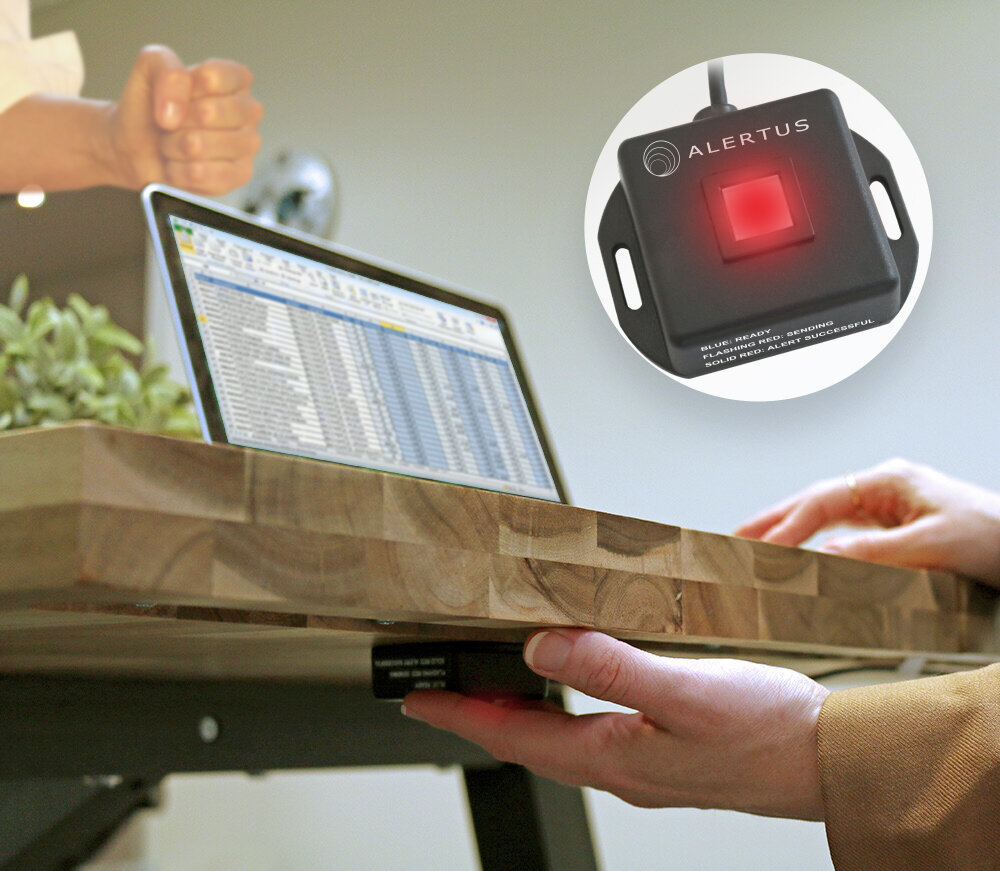A Comprehensive Guide for the Best Panic Button for Your Organization
By Rachel Choppin
Panic buttons (or duress buttons) offer a quick, single point of activation solution for your mass notification system. Alertus offers a variety of panic button options that leverage existing infrastructure and communication paths for immediate, one-step activation of your emergency alerts.
Below, we have compiled a comprehensive guide to which panic buttons will best fit the emergency communications needs for your organization, school, hospital, or facility.
Emergency Duress Buttons: Quickly activate your emergency notification system using pre-configured emergency activation buttons. These wall-mounted, hard-wired devices are simple to install and are highly effective. The buttons are available in a variety of colors with customizable text to display your pre-set emergency scenarios (i.e., Active Shooter, Evacuate, Shelter in Place, etc.) When an event happens, just press the button and immediately activate your pre-configured alerts across all integrated alerting devices.
Use Case: Toward the end of the workday, a manufacturing facility experiences a lockdown situation. The security manager presses the “Lockdown” emergency duress button which activates a facility-wide alert through integrated products such as an LED Marquee, Alert Beacon®, and mobile phones, notifying all employees to shelter in place and await further instructions.
Download our Emergency Duress Button Data Sheet for more information
Desktop Activator: This software-based panic button integrates with Alertus Desktop™ Notification to launch preset alerts instantly to decrease activation time in an emergency. It activates alert notifications using scenario hotkeys and task tray icons. Another added benefit to this software-based panic button is that the USB Panic Button is an extension of the Desktop Activator
Use Case: During the day at an elementary school, security receives a tornado warning. The security staff goes to the task tray on their computer and selects the preset alert for “Severe Weather,” and an alert is sent to the school through other integrated products such as Alert Beacons, desktops, LED Marquees, and more informing students, staff, and faculty where to go and how to react.
Watch our Alertus Desktop Activator Demonstration to learn more!
USB Panic Button: The USB Panic Button connects to PC’s and Mac’s running the Alertus Desktop Activator. This discreet, under-the-counter button trigger alerts when the user’s screen is locked, even without requiring a user to log in. Your organization’s alerts can be customizable depending on your needs and can be configured using custom event triggers.
Use Case: A disgruntled former employee walks into your building, creating a potentially dangerous situation. The receptionist discreetly reaches under their desk to push the USB Panic Button, triggering an alert to building security with the location of the event as well as sending an alert to the entire organization that there is an intruder situation in effect.
Watch our USB Panic Button Activation Demonstration see how it works!
Wireless Panic Button: This panic button comes in a lightweight, discreet design perfect for key chains or even mounted onto a desk. The wireless panic button quickly launches customizable preset emergency alerts for facility-wide activation, including your entire suite of Alertus products.
Use Case: A student has a medical emergency and their teacher presses their wireless panic button that quickly sends a request for help from school security.
Download our Wireless Panic Button Data Sheet to learn more.
There are other alerting devices that, while not specifically a “panic button” have panic button like features that you can use in an emergency. Devices that have panic button capability include:
The Alertus Recipient App: This app allows users to not only receive push notifications with emergency messages but allows users to send geo-tagged incident reports to emergency personnel via the panic button feature. Users can report an incident with his/her current location, attach a picture, and a customized message. Users can also use preset incident buttons (fire, help, intruder, etc.) to notify emergency management.
Use Case: A student is walking on campus when they see smoke coming from a building nearby. They open their Alertus Recipient App and select the “Fire” quick-action button, sending an alert to emergency personnel.
VoIP Integrations: You can use your IP phone as a “panic button” to send out clear and reliable alerts to specific groups and endpoints such as mobile phones or PA systems. This is done by creating shortcuts using extension numbers configured to different preset activations in your Call Manager System.
This integration also allows you to activate alerts directly from your Mass Notification System server, resulting in fast and efficient message delivery to all or select endpoints.
Use Case: There is a severe weather situation that requires immediate lockdown and evacuation. Emergency personnel can quickly use their VoIP phone hotkeys to send an alert to the entire organization with instructions on how to proceed.
Watch our Cisco Activation Video to learn more!
Alertus Solutions
Alertus offers an array of additional notification solutions to facilitate comprehensive alerting, including the wall-mounted Alert Beacon, LED Marquee, and mobile apps. These solutions communicate emergency alerts throughout your organization to keep staff and visitors safe.
If you’re looking for free resources to help you or your organization better understand and facilitate emergency management, please visit Alertus Resources.






